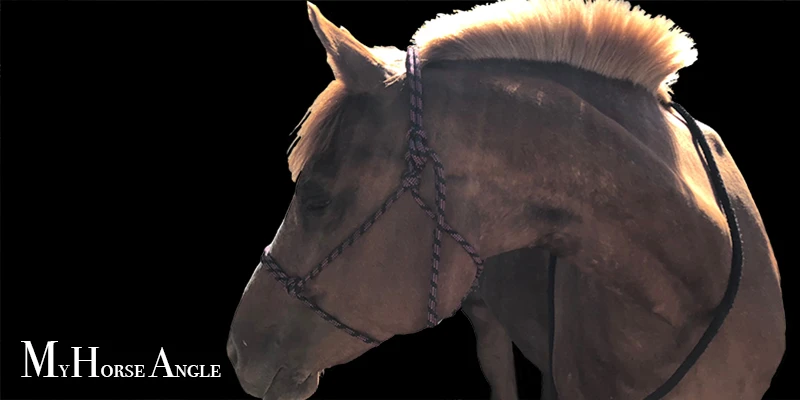As a reporter who was drawn to the profession because of writing, I’m constantly annoyed by the adage that a picture is worth a thousand words. And as a horse shopper, I’d argue that most sales pictures of horses are worth a good deal less than a thousand words.
The first draft cross I tried during my horse shopping journey was a resale. A woman a couple hours away from me had bought a gelding from a dealer several hundred miles away from her and was immediately displeased when the horse arrived.
“He looks like a cart horse,” she complained to me after I’d decided not to buy him because I wasn’t up to the training challenge. (Update: We’ve chatted since then. She still has him, and he is settling in a bit.)
As we commiserated, my mind wandered. The seller was reusing the original sales photos, and I wasn’t thrown by the gelding’s in-person appearance. The seller seemed savvy and down-to-earth and not like the sort to get wrapped up in a pretty face. To put it more plainly: I didn’t feel that I was smarter or a better horsewoman than her.
So why was I looking at the horse and thinking (appearance-wise) he was pretty much as advertised, and she was looking at him and thinking she got duped?
Then she solved the puzzle for me.
ADVERTISEMENT
“[The dealer] really knows how to take photos,” she said.
My instinct was to argue. The dealer knows how to take pretty photos but not how to take informative photos, I wanted to say. My argument might not be true—there’s a good chance that dealer knows exactly what they are doing— but the pretty/informative distinction triggered a moment of recognition for me.
The reason I’d not felt betrayed by the photos was because I’d never wholly trusted them in the first place. My brain had filled in negative information about the horse based on recognizing what was obscured in the photographs. That had nothing to do with my horsemanship skills and everything to do with having had an online dating profile from age 19 to nearly 31.
You only have to go on one date with a guy who is clearly pissed off to learn that you appear fatter in person than in photos before you become deeply paranoid about the pictures you use online to woo dates.
I developed a system. One picture within the past year that showed cheekbone, eye color and cleavage, a flattering full-body shot, then a picture of me looking happy or having fun but not necessarily flattering, then a sort-of run-of-the-mill photo that I thought was fair but not my very best.
I didn’t want to mislead anybody, but I also didn’t want to sell myself short. We used to call the cheekbone/eye color/boobs photo the “MySpace Angle.” It was usually taken slightly above, so the eyes were closer to the camera, your chin seemed narrow and your boobs stuck out and often blocked the view of your stomach.
ADVERTISEMENT
As I scrolled through the photos in the sales ad for the young draft cross, I realized we had a classic equine “MySpace Angle.”
When I see a boudoir-esque shot of a horse bending his neck towards his hindquarters, I don’t ogle pretty horse eyes and pricked ears and a long graceful neck and powerful-looking hindquarters. Instead, I immediately think “What hellscape of a midsection on this horse is the photographer trying to hide?”

This horse didn’t actually have a horror show of a midsection, but her seller let me photograph her like this to help prove my point. Also, her legs are much tidier than my Photoshop skills suggest! Nice mare, just not for me.
And then I sort through the sales pictures until I see the one that is “fair but not his very best.”
In the case of the young draft cross, I’d recognized ahead of time that the horse has a longer back than you’d expect from his more flattering photographs.
(Most advice you get about finding a horse capable of carrying heavier riders says you should look for a horse with a short back. There’s another school of thought, however, that says a longer back is better to accommodate bigger saddles, but the back needs to tie in well with the hindquarters. I thought he seemed OK in that regard, though if I’d decided that I wanted to buy him, I would have consulted with a vet before finalizing the decision.)
I realized I’d come to view sales photos as almost entirely subjective, with color being the only thing that’s accurately represented. Even that can be iffy. Ostensibly objective photographs can be faulty. Pseudo-conformation shots seem trustworthy, but a fresh grooming and a fine bridle distract from a picture that isn’t quite level enough. On a closer look, you realize the picture is at a slight angle and could be distorting the horse’s disproportionate legs.
I’ve come to realize that in sales ads and in dating photos, there’s no such thing as “just a bad picture.” The bad pictures are the truth. They aren’t the whole truth, because my big tummy doesn’t mean my eyes are less blue, and that horse’s long back doesn’t mean his feet were less sturdy. But photos are oftentimes the very start of the truth, if you know how to look at them.














